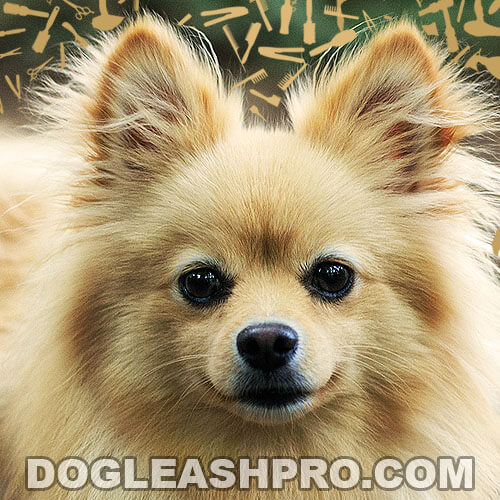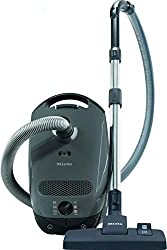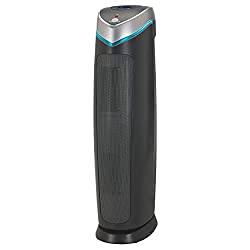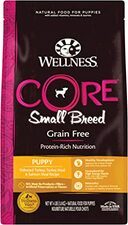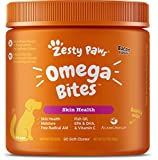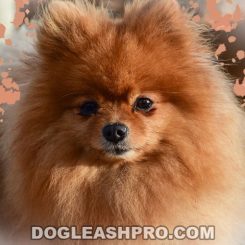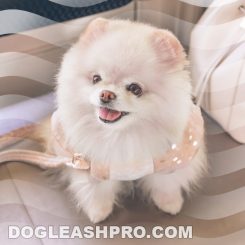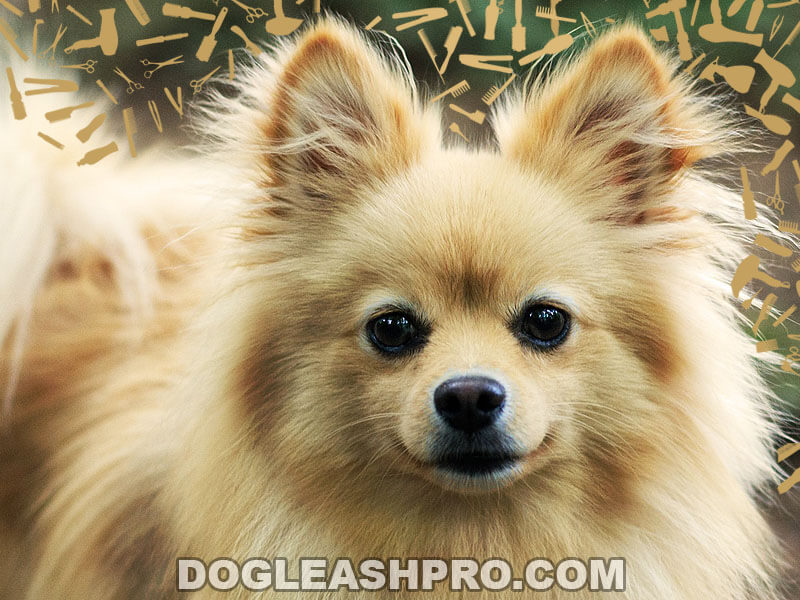
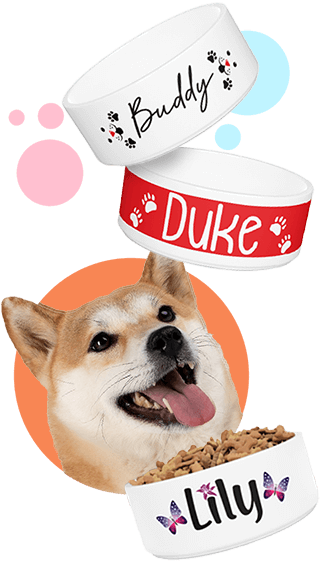
Do Pomeranians Shed? Yes, Pomeranians do shed and are considered moderate shedders. Pomeranians have a thick coat that is composed of 2 layers, an undercoat, and an outer coat. They moderately shed their inner coats all year round. But, it is during the fall and the end of spring when they shed heavily which is triggered by changes in temperature and daylight hours.
Pomeranians are one of the fluffiest dog breeds around. They belongs to the Spitz family which also includes an Alaskan Malamute and a Shiba Inu.
Spitz dogs are all double-coated which helps them regulate their body temperatures. These two layers of the coat are independent of each other, meaning, they do not grow in unison.
The undercoat is shorter and grows faster than the outer coat. It is the undercoat that sheds almost throughout the year but not too heavily. However, during a change in temperature, a Pomeranian shed a lot, which is also referred to as the seasonal blowing of the coat.
Table of Contents
Do Pomeranian Shed?
Yes, Pomeranians do shed. They shed their undercoat all year round. You may get frustrated about it but shedding is actually a natural cycle that is affected by several factors including the breed, age, season (and heat cycle for female Pomeranians).
As mentioned above, Pomeranians are double-coated dogs. Hence, when the weather begins to get cold or the nights are longer, they will experience heavy shedding of their thin undercoat to give way to a thicker and fuller undercoat.
On the one hand, once the weather changes to summer or shorter nights, Pomeranians shed their winter undercoat so a lighter undercoat can grow in replace of it.
Do Pomeranians Shed a lot?

Yes, Pomeranians shed a lot, more so during the changing of the season and weather, regardless of gender.
Now, if you’re wondering, do Pomeranian shed a lot after her heat cycle (which comes at least twice a year), then the answer is yes.
Plus, female Pomeranians shed a lot a few weeks after giving birth. That said, unless a female Pomeranian is spayed, she will shed more than a male Pomeranian each year due to fluctuating hormones.
How bad Do Pomeranians Shed?
So, do Pomeranians Shed bad? The answer is not as bad compared with heavy shedding dogs like Chow Chow. Pomeranians moderately shed their coat every day but it worsens during autumn and at the onset of summer.
During the heavy shedding seasons, it’s not unusual to see fur all around your home, be it indoors or outdoors.
Additionally, if you pet your Pom, you may see a handful of fur on your palms.
Plus, female Poms shed badly after their heat cycle and during the post-partum stage, so it’s common to see a thinning of fur.
How much Do Pomeranians Shed?
Pomeranian Shed hair depending on the reason for shedding. Let us compare the amount of shedding produced:
- The lightest shedding is the Pomeranian puppy shedding. The puppy loses his fur slowly which lasts for an average of 3 to 7 months.
- Moderate shedding every day is a normal occurrence for the Poms.
- The moderate to heavy level of shedding or seasonal blowing occurs twice a year.
- The heaviest shedding is after a mom begins to wean her puppies. It’s not uncommon to see Poms losing fur in clusters.
Pomeranian Shedding level
There are three (3) types or levels of Pomeranian shedding and these are Pomeranian puppy Shedding, seasonal shedding, and hormone-related shedding.
Let’s go over each one of them in detail:
1. Pomeranian Puppy Shedding
One of the main reasons why Pomeranians shed is age-related or what they call puppy shedding.
It’s important to note that Pomeranian puppies are not born with two (2) layers of coat right away. Instead, they have a single soft coat that will begin to transition to a double coat at around 4 to 6 months of age.
When you bring home your Pomeranian puppy from the breeder at 8 weeks of age, she looks like a cute and fluffy little ball with lots of furs.
Now, don’t be disheartened if you notice your puppy’s appearance begin to change from an adorable to an ‘ugly puppy stage or Pomeranian monkey stage’ which normally happens at about 4 months.
This is the time when the fur of your puppy will look dull and uneven. She may even have some bald sections that will really look very unsightly.
But, don’t feel bad because this is a normal process. This is the time when her baby fur sheds and slowly transitions to a double coat or adult fur. The Pomeranian ugly stage usually lasts for about 3 to 7 months.
2. Seasonal Shedding
To help a Pomeranian cope with the changing weather, from winter to summer, her inner coat sheds to either provide warmth during winter or to make them feel cool during the summer or spring seasons.
3. Hormonal-Related Shedding
The heat cycle causes great stress on a female Pomeranian’s body. As a consequence of her fluctuating hormones, shedding becomes heavier, to the point that some may even get slightly bald.
The same is true when she gives birth to her puppies. Shedding will get heavy around 6 to 8 weeks after giving birth due to hormonal changes.
Do Pomeranian puppies Shed?
Yes, Pomeranians shedding during puppyhood is normal. The reason why Pomeranian puppies shed is that their coat is developing from a single coat to their adult double coat that is thick, soft, and strong.
When Do Pomeranians Shed?
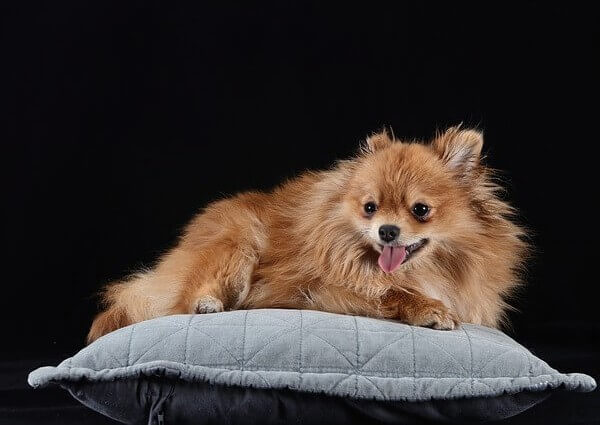
So, When Do Pomeranians Shed the most? Pomeranians shed the most during the summer and autumn, except for girls who shed after the heat cycle and giving birth.
Do Pomeranians Shed all year?
Yes, Pomeranians shed all year and they shed all year round because they are double-coated.
Do Pomeranians Shed in the fall?
Yes, Pomeranians shed a significant amount of fur during fall. This is because her body is preparing for the onset of winter.
Thus, the thinner summer undercoat has to shed for the thicker undercoat to grow in and act as insulation during cold days.
Do Pomeranians Shed in the summer?
What about summer? Do Pomeranians Shed in summer? The answer is yes, Pomeranians shed in the summer as well. This is now the time when her body is preparing her for the hotter days, hence, the thick undercoat has to shed so a lighter undercoat will grow in and keep her cool.
This allows for more air circulation and the cooling of bodies more effectively.
Do Pomeranians Shed in the winter?
Pomeranians shed when winter is about to finish. If winter is almost over, Pomeranians will shed off their bulky undercoat in preparation for warmer days ahead. This results in clumps of hair falling off.
Another reason why a Pomeranian may shed in the winter is because she may have a poor diet. Feeding your furry friends cheap food that is made with fillers means that your Pom is not digesting her food well.
Fillers like grains and corn are not healthy choices which can greatly affect the skin and coat conditions.
You may be interested in: Can Dogs Eat Tamales? (The Corn Husk Is Dangerous)
Lastly, it could be that you are not brushing your Pomeranian’s coat which causes shedding in winter.
Do Pomeranians get cold?
Yes, in spite of their thick coat, Pomeranians can feel the cold, too. The signs that your Pom is feeling cold include the following:
- Shivering.
- Lifting the paws off the ground.
- Whining.
- Not showing interest in going out.
Do Pomeranians like cold weather?
If you’re wondering, “Do Pomeranians like the cold?” the answer is it really depends on the individual Pom.
Some Poms have the capacity to overheat easily, meaning, they can manage to play for a few minutes in the cold weather to cool off. However, not all of them like it.
Coats for Pomeranian dogs
Regardless of whether your Pomeranian loves to enjoy the outdoors during the cold months or not, it’s healthy to look for coats for Pomeranians.
Being out in the cold for too long may cause hypothermia, a condition wherein the body temperature drops dangerously low.
To avoid your Pom from getting sick, let her wear Pomeranian coats such as the Pet Artist Winter Puppy Dog Coats.
We highly recommend this coat because it is made with an interior padded fleece with the exterior fabric preventing Pomeranian’s coat and skin from getting wet from the snow or rain.
Do Pomeranians like snow?
Yes, some of them do and love to play outside on a cold, winter day. While it’s safe, be sure to dress her up with a Pomeranian coat.
Take note though that the maximum time a Pom can play on the snow is 15 minutes, more so if the temperature is around 40°F.
Pomeranian Shedding season
| Seasons | Shedding Level |
| Spring | Moderate – High |
| Summer | Moderate |
| Fall/Autumn | Moderate – High |
| Winter | Moderate |
Are Pomeranians hypoallergenic?
No, Pomeranians are not hypoallergenic because they shed moderately 365 days a year, and even more so in some months.
Plus, a Pom carries a significant amount of dander that causes allergic reactions in those that are sensitive to pet allergy.
Thus, there is no such thing as a Pomeranian dog hypoallergenic.
WANT MORE INFORMATION? Check out Are Pomeranians Hypoallergenic? 15 Tips To Reduce Dog Allergy Around Your Home
Pomeranian coat types and colors
Pomeranians wear a double layer of coat.
There is the undercoat, which is composed of soft and dense fur.
Then there’s the top coat which consists of coarse and medium-length fur.
The Pomeranian’s coat can come in the following colors:
- Orange.
- Black.
- White.
- Sable.
- Red.
- Blue.
- Tan.
- Chocolate.
- Two-colored.
- Tri-colored.
RELATED: Lavender Pomeranian (Complete Guide)
Are Pomeranians double coated?
If you’re asking, “Do Pomeranians have a double coat?” The answer is yes, a Pomeranians do have double coat. The double coat consist of a top coat and a Pomeranian undercoat.
Do Pomeranians have hair or fur?
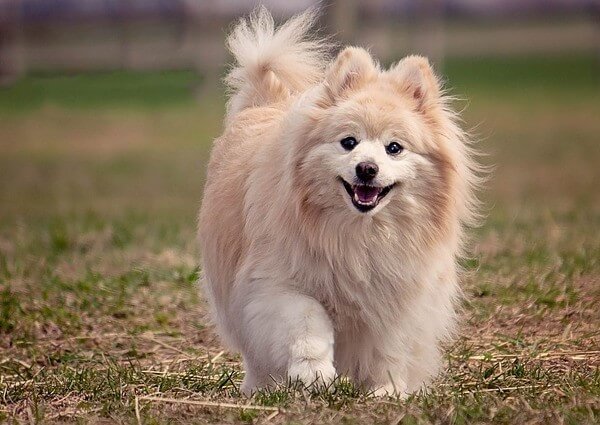
If you’re wondering whether Pomeranians have hair or fur, you’re not alone. A lot of people are also wondering the same thing: Pomeranian hair or fur?
To differentiate between the two, fur is shorter and does not grow as long as hair. Also, the growth cycle of fur is shorter and this is why dogs with fur are moderate to heavy shedders as opposed to dogs with hair that shed minimally only.
In the case of Poms, what they have is Pomeranian fur so they also shed and produce more amounts of dander.
Long haired Pomeranian
A long hair Pomeranian has a medium-length coat that appears fluffy in about 1 to 2 years.
Why is my Pomeranian not fluffy?
If your Pom is less than a year old, it’s normal for her coat to not display some fluffiness, just yet.
Another reason why your Pom may not have a fluffy coat can be due to a disease like the black skin disease.
Hairless Pomeranian
Is there such a thing as a a hairless Pomeranian dog? No, there is no such thing as a Pomeranian without hair. If you see a Pomeranian without fur, it is highly likely that the dog suffers from alopecia which is a skin condition causing Pomeranian losing hair. Alopecia is a hereditary disease.
Pomeranian hair loss
The culprit for Pom’s hair loss is a hereditary condition called black skin disease also known as Alopecia X. This is a problem that causes the skin to turn dark or black and later on, the Pomeranian may begin to lose her fur.
Other factors like allergies and stress can also cause hair loss in Pomeranians.
Why Do Pomeranians Shed so much?
Aside from their thick double coats that shed naturally, some may wonder, “Why is my Pomeranian Shedding so much?”
There are other reasons that may contribute to the shedding of a Pomeranian and these include nutrient deficiency, dehydration, parasites, food allergies, stress, and other health issues.
We will discuss these factors in great detail below.
Pomeranian double coat
Dogs that are double-coated and have fur instead of hair will shed moderately all throughout the year.
Pomeranian puppy coat change
The transition from a puppy single coat to an adult double coat causes shedding among Pom puppies.
Pomeranian Shedding season
The change of temperature from hot to cold and vice versa can also cause heavy shedding.
Nutrient Deficiency
Lack of certain nutrients in their diet, like omega-3 fatty acids, magnesium, potassium, and certain vitamins can make their coats shed more due to a less healthy skin condition.
Omega-3 fatty acid helps in keeping their skin hydrated and moisturized by protecting their hair follicles.
Magnesium is involved in various enzymatic reactions in the body, while potassium helps in the electrical functioning of the heart, muscles, and nerves.
Vitamins A, B, C, E, and K all help in skin growth and repair, as well as, offer support for their immune system.
RECOMMENDED: How to Get Your Dog to Eat When Sick
Dehydration
It is well-documented that having properly hydrated skin means healthy skin. Water is essential in proper organ functioning, flushing out toxins, balancing the pH balance, and improving skin elasticity by retaining moisture.
DON’T MISS: What Can Dogs Drink Besides Water?
Parasites on your Pomeranian
External parasites, such as ticks, fleas, and mites can contribute to a Pomeranian’s hair loss. These parasites live on their skin and ingest their blood which releases saliva that can cause skin itchiness.
READ ALSO: Dried Dead Tick On Dog: How To Remove & What To Do
Internal parasitic worms found in the intestines, such as tapeworms and hookworms, as well as, the single-celled parasite Giardia can also cause skin issues since the malabsorption of food robs them of the proper nutrients needed by the body.
Hair loss due to parasites can easily be diagnosed by a veterinarian by doing a simple physical exam or checking the blood chemistry for any parasitic manifestations.
READ NEXT: White Specks in Dog Poop (Not Moving): What Should You Do?
Treatment depends on the type of parasites with the appropriate medicated dog shampoos being prescribed for fleas and ticks, or a deworming medication for intestinal worms.
One proven effective way of preventing fleas and ticks from spreading around your home is by properly vacuuming your house, especially the carpets and hard-to-reach places.
Studies show that vacuuming can kill fleas in all stages of life from the larval stage to adulthood.
Pomeranian allergies
Grass, pollen, strong perfumes, and dust mites are typical environmental allergens that can trigger a skin reaction in a Pomeranian when inhaled or absorbed by their skin.
Symptoms include excessive itching and licking, reddish skin, and hair loss. An allergy shot or antihistamine medication may be prescribed by the veterinarian or certain topical creams can be applied to the skin.
CHECK OUT: Dog Losing Hair Around Eyes? (9 Top Reasons + What To Do)
Using an air purifier around your home, preferably with HEPA filters, can effectively reduce the number of allergens present in the air.
Those with carbon or charcoal filters can also eradicate bacteria, mold, and other pathogens.
Pomeranian food allergies
Pomeranians are known to be sensitive to certain type of foods that can cause their skin to get irritated and also affect their bowel movement.
Here are some food allergies to be aware of if you have Pomeranians:
Wheat
Gluten, which is a main component of wheat, is found to cause rashes and itching among Pomeranians.
You may be interested in: Can Dogs Eat Crackers?
Soy
Soy is a legume that is said to cause liver and kidney disease, as well as, thyroid problems in Pomeranians.
Corn
Some dog foods list corn as their main ingredient. Corn is usually used as a substitute to whole grains such as whole rice, barley, or oatmeal.
Excessive sugars from corn can cause minor irritation and also cause diabetes in the long run.
You may also like: Can Dogs Eat Tortilla Chips?
Dairy Products
The lactose in milk products can cause skin itchiness and other skin problems.
DON’T MISS: Can Dogs Drink Ensure? Can I Give My Dog Ensure?
Beef
Certain foods like beef can develop allergic reactions overtime if their diet is not kept diverse.
RECOMMENDED: Can Dogs Eat Beef Rib Bones?
Eggs
Proteins found in the egg yolk can cause allergic rashes in some Pomeranians.
READ NEXT: Can Dogs Eat Egg Salad?
Stress and anxiety
Stress and anxiety can affect the shine and texture of a Pomeranian’s coat that would eventually lead to hair loss due to the release of the chemical epinephrine in the body.
Signs of stress include excessive panting, pacing, drooling, and increased heart rate.
Hormonal Changes
Female Poms who come into heat or have given birth go through hormonal changes that cause shedding.
Pomeranian health issues
Health issues such as hypothyroidism wherein the body doesn’t produce enough thyroid hormones can cause dryness of skin and eventual hair loss.
Another health concern is Black Skin Disease, as we mentioned above, that can cause hair loss. It typically occurs in the groin and leg area, with the skin having hyperpigmentation appearing as light brown to black.
The cause is unclear but it may be due to genetics or hormonal imbalance.
How to stop Pomeranian from Shedding?
Shedding cannot be completely stopped in a Pomeranian but it can be controlled.
Here are several things you can do to avoid too much hair taking over your home.
15 Easy Pomeranian Shedding Tips
1. Brush your Pomeranian frequently
The importance of regularly brushing your Pomeranian cannot be emphasized enough. Brushing not only frees their undercoat of dead loose hair that would otherwise cause matting but also helps spread the natural oils that keep their coat shiny.
Dead loose hairs can clog up just above their skin and prevent the natural airflow and block their skin pores. This may eventually lead to bad odors.
It is recommended that their coat be brushed at daily. Lactating mothers tend to shed the heaviest after they’ve weaned their litters and should be brushed daily.
2. Use the right tools
Using a wide-tooth steel comb is recommended to brush their main body, while a fine-toothed comb is ideal for the face and paws.
To take out loose and dead hairs, use a slicker brush that could easily reach into the inner coat.
But during the heavier shedding season, some would recommend using a de-shedding tool such as the FURminator to better remove the matting.
Brushing a Pomeranian typically takes around 15 to 30 minutes, and for those that are busy, this may seem too long.
You’ll want to plan a schedule wherein you and your Pomeranian can both be calm and relaxed preferably when you are watching your favorite show or after a meal.
3. Invest in a powerful vacuum cleaner
Vacuum cleaners such as the Miele Vacuum Cleaner have the power to suck out pesky fleas and ticks embedded in your carpet, upholstery, or crevices in your home. The powerful suction can take out most of these parasites in all their stages including their eggs and larva.
4. Use a robot vacuum
Robot vacuums are a great addition to your cleaning kit that is better suited to larger homes with wall-to-wall carpeting where parasites and dust mites can easily settle.
This machine not only saves you time but also is much quieter than regular vacuums which can scare away dogs with their loud, high frequency sounds.
However, do keep in mind that robot vacuum can be a bit problematic. There have been cases of dogs getting their tails caught in the robot vacuum.
In the worse case scenario, if your puppy is not potty trained and accidentally poop on your hardwood floor or carpet, the robot vacuum may actually cause a bigger mess as it runs through the poop or pee.
5. Use an air purifier with HEPA filter
Using air purifiers with high-efficiency particulate air (HEPA) filters can trap tiny particles in the air, like pollen, pet dander, molds, and dust mites by forcing air through a fine mesh.
This would reduce the chances of your Pomeranian from having allergic reactions and respiratory infections from these tiny particles.
6. Stock up on lint rollers
Lint rollers can easily pick up dirt, dander and loose hairs that can cleanup the surface of your furniture.
7. Avoid bathing your Pomeranian too often
Frequent bathing could dry your Pomeranian’s skin and this would eventually lead to skin irritation, inflammation, and hair loss.
In between baths, you can spray on a leave-in conditioner after every brushing that has the benefit of repelling dirt.
You can also use grooming wipes every 2 to 3 days to keep their coat clean and smelling good.
How often should Pomeranians be bathed?
Pomeranians should be bathed once every 2 to 3 weeks to remove any excess oil and dirt or debris on their coat. Make sure to brush their coat before bathing to get rid of the matting and tangles.
After patting them dry or blow drying their coat, you’ll want to brush their coat again to prevent fungus growth.
8. Using the right dog shampoo
When you do bathe your Pom, be sure to use a shampoo that not only cleanses but also moisturizes their coats. This would provide protection from any skin irritations.
Avoid using human shampoo which contains higher acidity that could harm their skin. Instead, you’ll want to opt for a dog shampoo that contains natural ingredients, like aloe vera or oatmeal, which soothes their skin, reduces inflammation and also controls excessive shedding.
How to keep my Pomeranian smelling good?
Aside from regular brushing and bathing, Pomeranians can be kept smelling good by also regularly checking their ears for any debris and excess moisture.
Their paws should also be checked especially if they are active. Using a paw wax keeps their paws well moisturized, as well as, repels dirt and other irritants.
9. Nutritious and high-quality dog food is a must
Feeding your Pomeranian a well-balanced diet will ensure that their skin and coat are healthy. Foods with essential omega-3 and omega-6 fatty acids not only promote skin and coat health but also is crucial for their overall development and immunity.
10. Taking the right supplements for healthy skin and coat
Vitamins and minerals that promote supple skin and luscious coat include biotin, zinc, vitamins A, C, E, and K. With the right dosage, supplements can keep their skin healthy and also help in healing skin wounds.
11. Exercise, exercise, exercise!
Regular physical activity gets your Pomeranian’s heart pumping smoothly, thus, improving blood circulation to their skin.
12. Bring your Pomeranian for his regular vet check-up
Regular veterinary checkups ensure that your Pomeranian is strong and healthy all year round. Any minor health issues can easily be solved that would otherwise affect the condition of their skin and coat if left untreated.
13. Trim when needed, but never shave!
Shaving or clipping fur close to the skin can damage the hair follicles of the Pomeranian. Their coat not only protects their skin but also helps them in regulating their body temperature so it’s important that you simply trim, but never shave.
READ ALSO: Dog Grooming For Beginners At Home (Dos and Don’ts)
14. Spay or neuter your Pomeranian
Spaying or neutering a Pomeranian between the ages of 6 to 9 months reduces their chances of developing testicular cancer in males and uterine infections in females ensuring that they would live longer.
Sterilization also affects their behavior, making them more good-tempered and therefore much physically healthier.
15. Accept Pomeranian hair as a part of your life
Shedding is a natural process in Pomeranians that helps to keep their skin and coat healthy. They need to rid themselves of the old and unneeded undercoats to make way for new growth that would protect their bodies from the harsh elements.
Pomeranian coat stages
The Pomeranian coat changes or sheds depending on age, gender, and season.
The first time you will notice a Pomeranian shedding or changing her coat is when she is transitioning into adulthood.
Pomeranian puppies typically undergo a stage called the “ugly puppies” phase wherein their puppy coat would start to fall out and appear raggedly thin or scraggly.
The second type of shedding is when a mother Pomeranian will shed her coat after weaning her litter due to hormonal changes. This is the heaviest type of shedding seen among the breed.
The third type of shedding is due to seasonal changes when they blow their coat to adapt to changing temperatures.
Do Teacup Pomeranians Shed?
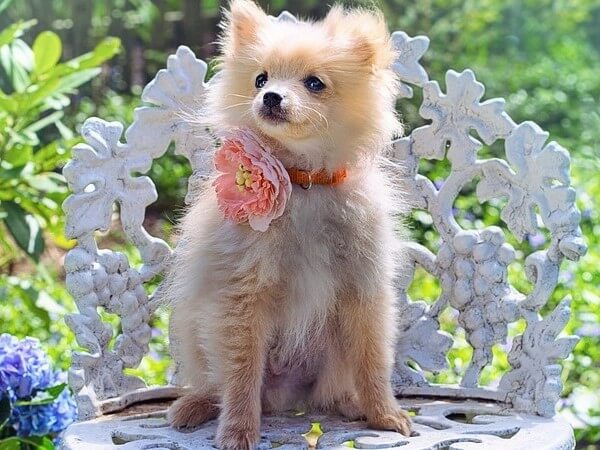
Because of their small size, some may wonder, “Does teacup Pomeranian Shed their coat?
The answer is yes, Teacup Pomeranians do shed their coat moderately throughout the year just like the standard-sized Pomeranians.
CHECK OUT: Teacup Pomsky (Complete Guide)
Do Teacup Pomeranians Shed a lot?
No, the Teacup Pomeranian is not a heavy shedder but rather a moderate shedder. However, loose fur can still spread around your house if they are not brushed regularly.
Do Micro Pomeranians Shed?
Yes, Micro Pomeranians shed despite their small size.
Do Mini Pomeranians Shed?
The Mini, Teacup, and the Micro Poms are all one and the same miniature versions of the Pomeranian. And, similar to their standard-sized cousins, the Mini Pomeranian shed as much as the next Pomeranian regardless of their size.
Do Teddy Bear Pomeranians Shed?
Yes, the Teddy Bear Pomeranians with their shorter face and muzzle are also moderate shedders.
Do Toy Pomeranians Shed?
The Toy Pomeranian is another term for the Mini Pomeranian, thus, she sheds her coat similarly to the standard Pomeranian.
However, because of their smaller size, the shedding will not be as conspicuous as that of her bigger cousin.
Do Pomchis Shed?
Yes, the Pomchi shed throughout the year since the Pomeranian and the Chihuahua are shedders.
However, the Chihuahua sheds less compared to the Pomeranian, so expect Pomchi adults to be light to moderate shedders.
Pomchi Shedding also tends to be heavier during the fall and spring months when their body is adapting to either the incoming warmer or colder temperatures.
So, do Pomeranians Shed?
Pomeranians do shed just like most double-coated breeds. Shedding is a natural process that lets old hair be replaced by new ones. Since Pomeranians are moderately shedding dogs, this breed might not be the ideal choice for those who are sensitive to pet allergy.
Also, people who are busy all the time may not be the best owners of this breed since their coat requires some degree of care and grooming to keep them maintained in good shape.
Related Questions
For the most part, the Pomeranian is pretty manageable and easy to take care of. The only thing that requires regular maintenance is their grooming. They need to be brushed at a minimum of 2 to 3 times per week to control shedding and keep their coats free of matting. They also need to be professionally groomed every 4 to 6 weeks to maintain the desired length and shape of their coat, as well as, to trim their nails, clean their ears, and express their glands.
The least shedding dog breed is the American Hairless Terrier because of the absence of any hair in their body except for their eyebrows and whiskers. Other least shedding dog breeds include the Afghan Hound, Bichon Frise, Maltese, Schnauzer, Poodle, and Yorkshire Terrier.
Unfortunately, there are no Pomeranians that don’t shed.
It is impossible to stop shedding in a Pomeranian, but it can be controlled through regular brushing and grooming.
Yes, they need their coats to be trimmed and shaped every 4 to 6 weeks.
Pomeranians do not normally have a bad smell. It is only when their skin and coat are not properly dried that it might get smelly due to the presence of bacteria or fungus.
DISCLAIMER: THIS WEBSITE DOES NOT PROVIDE MEDICAL ADVICE
The information, including but not limited to, text, graphics, images and other material contained on this website are for informational purposes only. No material on this site is intended to be a substitute for professional veterinary advice, diagnosis, or treatment. Always seek the advice of your veterinarian or other qualified health care provider with any questions you may have regarding a medical condition.
Resources:
https://ampomclub.org/pomeranian-health/
https://www.wikihow.com/Take-Care-of-a-Pomeranian

With over five years of specialized experience as an animal writer, my expertise lies in dog nutrition, health, behavior, grooming, and training. I am dedicated to delivering helpful and informative content that caters to the well-being of our furry friends. My primary goal is to empower pet owners with knowledge and ensure our canine companions thrive in health and happiness. In my free time, I love volunteering at local dog rescue centers.
